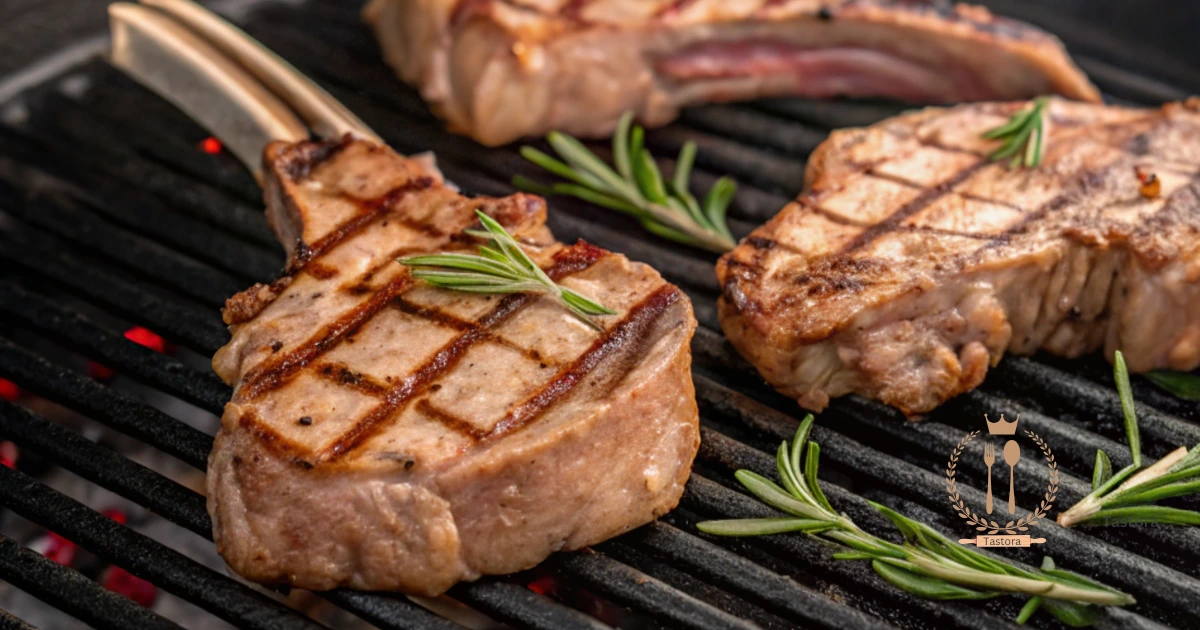How to Make Perfectly Grilled Lamb Shoulder Chops Every Time
Grilled lamb shoulder chops are the unsung heroes of summer cookouts, offering a perfect balance of affordability, flavor, and ease that often gets overlooked in favor of their more expensive counterparts. Unlike delicate lamb racks or pricey loin chops, shoulder chops deliver a robust, meaty flavor profile that stands up beautifully to the intense heat and smoky essence of grilling. Their natural marbling and distinctive grain structure ensures they remain juicy and tender when cooked properly, making them remarkably forgiving for both novice and experienced grill masters.
In this guide, you’ll discover how to transform this underrated cut into a mouthwatering centerpiece that will have your guests wondering why they’ve been spending so much more on other cuts. We’ll walk through selecting the perfect chops, preparing them with a flavor-enhancing marinade, mastering the grilling technique for that ideal balance of char and juiciness, and presenting them with complementary sides that elevate the entire meal. By the time you finish reading, you’ll be equipped with the knowledge to turn these humble chops into a restaurant-worthy dish that celebrates lamb’s rich heritage and distinctive flavor.
Choosing the Best Lamb Shoulder Chops for Grilling
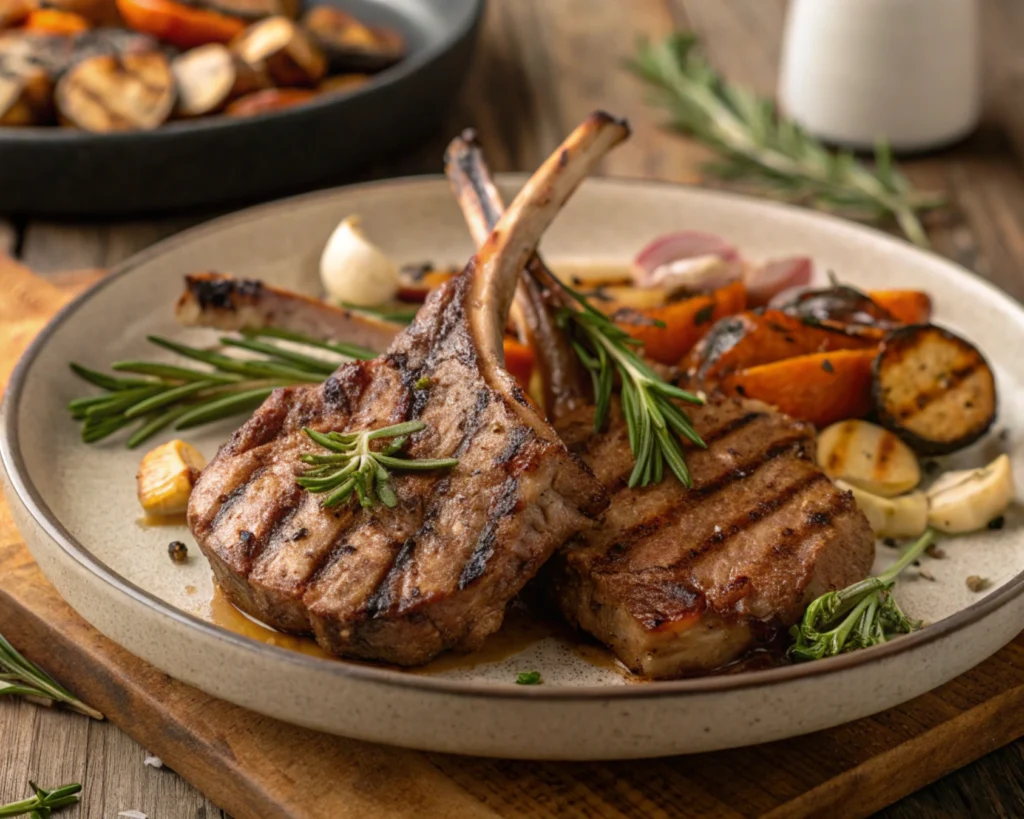
What to Look for When Buying Lamb Shoulder Chops
When selecting lamb shoulder chops for grilling, appearance is your first quality indicator. Look for cuts with a bright pinkish-red color – this signals freshness and proper handling. Avoid chops that appear brown or have an off-putting smell, as these are signs of age or improper storage. The fat should be firm and white or slightly creamy in color, never yellowish.
Marbling – those fine streaks of fat running through the meat – is particularly important for shoulder chops. Unlike leaner cuts, a good amount of intramuscular fat is desirable here as it will melt during cooking, basting the meat from within and developing rich flavor. However, balance is key – excessive exterior fat can cause flare-ups on the grill, so look for chops with well-trimmed fat caps about 1/4-inch thick.
Thickness matters significantly when grilling. Aim for chops that are at least 1 to 1.5 inches thick. Thinner cuts will cook too quickly and potentially dry out before developing a proper sear, while excessively thick cuts may char on the outside before cooking through. Uniform thickness ensures even cooking, so examine the chops from all angles before purchasing.
Recommended Cuts and Why Shoulder Chops Work Well for Grilling
Lamb shoulder chops come in two main varieties: blade chops (cut from the shoulder blade) and arm chops (from the lower portion of the shoulder). Both excel on the grill but offer slightly different experiences. Blade chops contain a portion of the shoulder blade bone, have slightly more fat, and offer complex flavor with varied texture. Arm chops contain a round cross-section of arm bone, have a more uniform texture, and tend to be slightly leaner.
Shoulder chops work exceptionally well for grilling primarily because of their muscle structure and fat content. These cuts come from an area of the animal that gets significant exercise, developing more connective tissue and deeper flavor than sedentary muscles. When exposed to the high heat of grilling, this connective tissue breaks down into rich gelatin, contributing to a succulent mouthfeel.
Another advantage is their thickness and bone structure. The bones conduct heat more slowly than meat, creating a temperature gradient that helps prevent overcooking. This makes shoulder chops more forgiving on the grill compared to boneless cuts, giving you a wider window of perfect doneness.
Where to Buy Quality Lamb
Developing a relationship with a local butcher offers numerous advantages when purchasing lamb shoulder chops. A good butcher can cut chops to your preferred thickness, answer questions about the lamb’s origin and aging, and may even set aside prime cuts for regular customers. Additionally, many butchers source from smaller, regional farms with higher animal welfare standards.
Quality grocery stores with dedicated meat counters are increasingly offering better selections of lamb. Look for stores that provide information about sourcing and handling practices. Some national chains like Whole Foods and specialty grocers offer grass-fed, humanely raised options that typically translate to better flavor.
Farmers’ markets provide an opportunity to purchase directly from the producer. This direct connection allows you to ask detailed questions about raising practices, feed, and handling. Many small farmers raising lamb on pasture sell at seasonal markets, offering meat that’s typically harvested more recently than what’s available at standard retail outlets. The lamb may cost more, but the superior flavor, ethical raising practices, and opportunity to support local agriculture often justify the premium.
Ingredients for Grilled Lamb Shoulder Chops:
- 4 lamb shoulder chops (about 1-inch thick)
- 2 tbsp olive oil
- 2 cloves garlic, minced
- 1 tsp salt
- 1/2 tsp black pepper
- 1 tsp dried oregano
- 1 tsp fresh rosemary, chopped
- 1/2 tsp paprika
- 1 tbsp lemon juice
Method of Preparation:
- Prepare the Marinade: In a small bowl, combine olive oil, minced garlic, salt, black pepper, dried oregano, fresh rosemary, paprika, and lemon juice. Mix well to form the marinade.
- Marinate the Lamb: Rub the marinade generously onto both sides of the lamb shoulder chops. Let them sit for at least 10 minutes to allow the flavors to infuse.
- Preheat the Grill: Preheat your grill to medium-high heat, about 400°F (200°C). Lightly oil the grill grates to prevent sticking.
- Grill the Chops: Place the lamb shoulder chops on the grill. Grill for 5-7 minutes per side, depending on your preferred doneness (medium-rare is about 130°F internal temperature, medium is 145°F).
- Rest the Meat: Once cooked to your desired doneness, remove the lamb chops from the grill and let them rest for 5 minutes to allow the juices to redistribute.
- Serve: Serve the grilled lamb shoulder chops with your favorite sides like roasted vegetables, mashed potatoes, or a fresh salad. Enjoy!
This recipe yields 4 servings and can be paired with a variety of sides to make a complete and satisfying meal.
The Best Marinade and Seasoning for Lamb Shoulder Chops
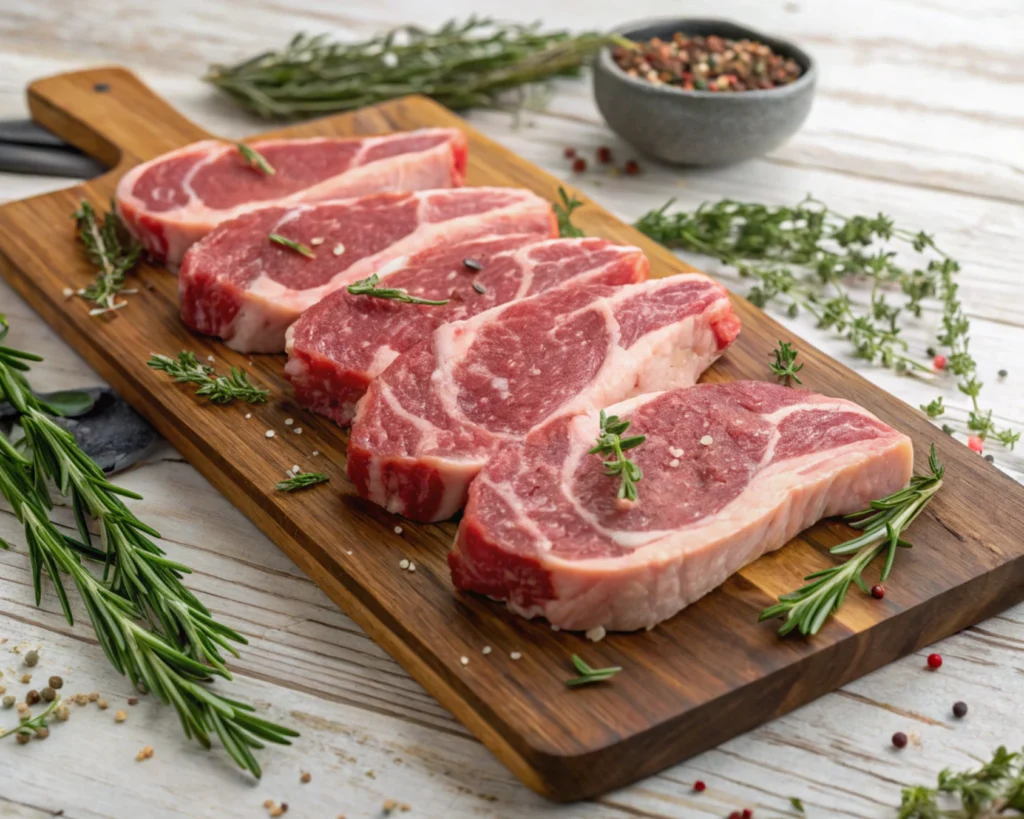
Essential Ingredients for a Flavorful Marinade
A well-crafted marinade enhances lamb’s natural flavor while helping to tenderize this sometimes sturdy cut. At the foundation of any good lamb marinade is high-quality olive oil, which helps carry fat-soluble flavors into the meat while contributing its own fruity notes. For shoulder chops, a robust extra virgin olive oil stands up well to the meat’s natural intensity.
Garlic is non-negotiable when marinating lamb – its pungent complexity seems almost designed to complement the meat’s distinctive character. For the best results, use fresh garlic cloves crushed or minced to release their full aromatic potential. Six to eight cloves per cup of marinade creates a foundation of flavor without overwhelming the lamb’s natural taste.
Fresh herbs bring brightness and dimension to the marinade. Traditional Mediterranean pairings like rosemary, thyme, oregano, and mint each offer something unique – rosemary’s resinous intensity, thyme’s earthy complexity, oregano’s warm pungency, or mint’s cooling sweetness. Using a combination creates a more nuanced flavor profile than relying on a single herb.
Acid components like lemon juice or vinegar serve dual purposes – they help tenderize the meat by breaking down muscle fibers while adding brightness that balances lamb’s richness. Fresh lemon juice excels here, contributing both acidity and its own aromatic compounds. For deeper complexity, balsamic or red wine vinegar brings subtle sweetness and depth.
Additional aromatics worth considering include shallots (milder than onions but more complex), anchovies (which dissolve and add umami without fishiness), and Dijon mustard (which helps emulsify the marinade while adding tangy depth). A touch of sweetness from honey or brown sugar can help balance the acids and promote caramelization on the grill.
How Long to Marinate for the Best Results
The ideal marination time for lamb shoulder chops balances flavor penetration against textural changes. Unlike tougher cuts that benefit from extended marination, shoulder chops reach their optimal point between 4 and 8 hours. This timeframe allows flavors to permeate beyond the surface while maintaining the meat’s desirable texture.
For marinades heavy in acidic ingredients (lemon juice, vinegar, yogurt), limit marination to 6 hours maximum. Extended exposure to acids can break down proteins excessively, resulting in mushy exterior texture. If your schedule requires longer marination, reduce the acidic components by half.
Temperature plays a crucial role in safe, effective marination. Always marinate in the refrigerator between 33-40°F, never at room temperature. For even flavor distribution, use a container that allows the chops to lie flat with minimal overlap, or better yet, a sealed plastic bag with the air expressed, which maximizes contact between the marinade and meat surface.
For the most pronounced flavor development, flip the chops halfway through the marination period. When ready to grill, remove the chops from refrigeration 30-45 minutes beforehand, allowing them to approach room temperature for more even cooking. Pat them dry with paper towels before grilling to encourage proper searing rather than steaming.
Alternative Dry Rub Options for Quick Seasoning
When time doesn’t permit marinating, a well-formulated dry rub can deliver remarkable results in as little as 30 minutes. The key to successful dry rubs for lamb shoulder chops is balancing bold flavors that complement without overwhelming the meat’s natural character.
A Mediterranean-inspired rub might combine two tablespoons each of dried rosemary and thyme, a tablespoon of garlic powder, a tablespoon of kosher salt, two teaspoons of freshly ground black pepper, and a teaspoon of dried oregano. For deeper dimension, add a teaspoon of ground coriander and a half teaspoon of cinnamon, which enhances lamb’s savory qualities without making it taste sweet.
For a North African twist, combine two tablespoons each of cumin and coriander, a tablespoon of paprika (sweet or smoked), two teaspoons of kosher salt, a teaspoon each of ground black pepper and ground ginger, a half teaspoon of cinnamon, and a quarter teaspoon of cayenne for heat. This profile creates a warming, aromatic crust that highlights lamb’s earthy qualities.
To apply a dry rub effectively, first pat the chops completely dry with paper towels. Apply a thin layer of olive oil to help the rub adhere and promote browning. Sprinkle the rub generously on all surfaces, pressing gently to ensure it adheres. Allow the seasoned chops to rest at room temperature for 30-60 minutes before grilling, giving the salt time to partially penetrate the meat and the dried herbs time to rehydrate from the meat’s moisture.
Step-by-Step Guide to Grilling Lamb Shoulder Chops
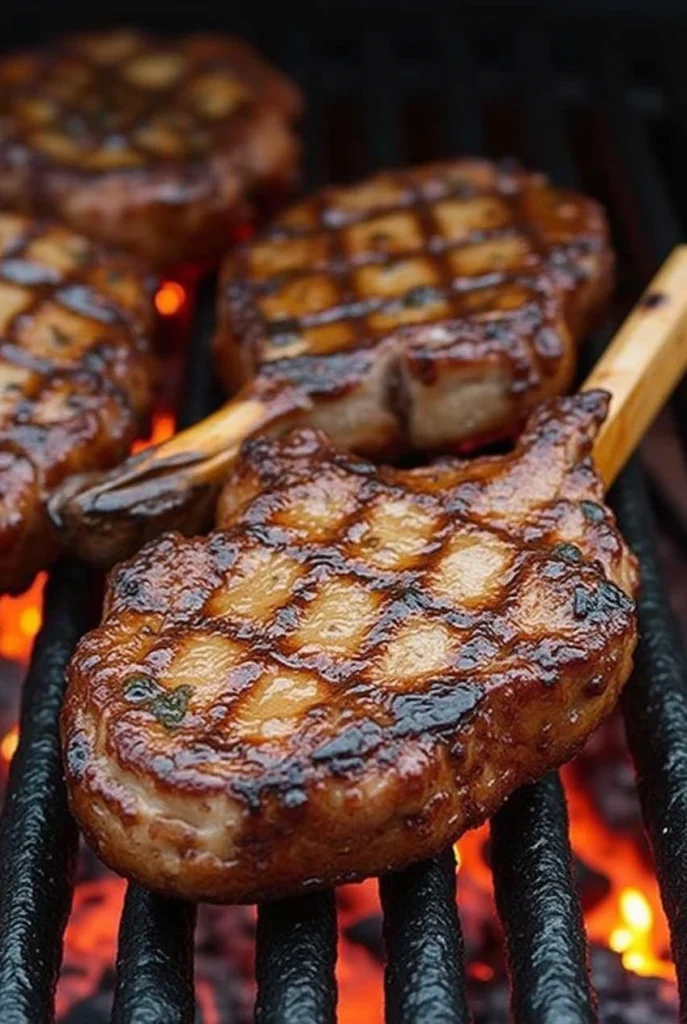
Preparing the Grill
The foundation of perfectly grilled lamb shoulder chops begins with proper grill setup. Both charcoal and gas grills can yield excellent results, but each requires specific preparation to achieve the ideal cooking environment.
For charcoal grilling, which many enthusiasts prefer for its superior smoke profile and higher heat capability, start with a chimney starter filled with quality hardwood charcoal. Once the coals are glowing and covered with light ash (approximately 20-25 minutes), arrange them to create dual cooking zones: pile approximately 75% of the coals on one side of the grill for high-heat searing, leaving the other side with fewer coals for indirect cooking. This two-zone setup provides versatility for controlling cooking speed and managing flare-ups. For enhanced flavor, consider adding a few chunks of hickory, oak, or fruitwood like apple or cherry to the coals just before cooking.
Gas grill preparation focuses on similar principles but with different execution. Preheat your grill with all burners on high for 10-15 minutes, achieving maximum temperature (ideally 500°F or higher). Just before cooking, adjust the burners to create your dual-zone setup: leave one or two burners on high for searing, while reducing the others to medium-low or turning them off completely for indirect cooking. For gas grills lacking in smoky flavor, consider using a smoker box with wood chips soaked for 30 minutes, placed over a lit burner.
Regardless of grill type, cleaning the grates thoroughly is essential. Once hot, scrub with a quality grill brush to remove any residue from previous cooking, then oil the grates using tongs and an oil-soaked paper towel. This cleaning and oiling process creates a non-stick surface that promotes perfect grill marks while preventing the lamb from tearing when turned.
How to Grill Lamb Shoulder Chops to the Perfect Temperature
Lamb shoulder chops benefit from a two-stage cooking approach that develops a flavorful crust while ensuring the interior reaches the ideal temperature without drying out. Begin by placing the chops on the hottest part of the grill for the initial sear. Cook undisturbed for 3-4 minutes until well-marked and they release easily from the grate. Resist the temptation to move them prematurely, which would prevent proper sear development.
After achieving good marks on the first side, flip the chops and sear the second side for 2-3 minutes. Once both sides have developed a good crust, assess the internal temperature using an instant-read thermometer inserted into the thickest part of the meat (not touching bone). For optimal texture and flavor, most culinary experts recommend medium-rare (130-135°F) to medium (135-145°F) for lamb shoulder chops. At this point, if the chops haven’t reached your target temperature, move them to the cooler zone to finish cooking with indirect heat, which reduces the risk of charring the exterior before the interior is done.
Temperature guidance for lamb shoulder chops:
- Rare: 120-125°F (not generally recommended for shoulder cuts)
- Medium-rare: 130-135°F (pink center, tender, juicy)
- Medium: 135-145°F (slightly pink center, good balance of tenderness and flavor)
- Medium-well: 145-155°F (minimal pink, firmer texture)
- Well-done: 155°F and above (no pink, significantly firmer)
Remember that carryover cooking will raise the temperature 5-10 degrees after removing the chops from the grill. To accommodate this, remove the chops when they’re about 5 degrees below your target temperature.
Tips for Achieving a Good Sear While Keeping the Meat Juicy
Achieving the perfect balance between a well-developed exterior crust and a juicy interior requires attention to several critical factors. First, ensure your chops are completely dry before they hit the grill – excess moisture creates steam, inhibiting proper browning. Pat marinated chops thoroughly with paper towels, being careful not to remove all the flavorful marinade components.
Managing fat is essential for preventing flare-ups that can cause acrid flavors and uneven cooking. Before grilling, trim exterior fat to a maximum thickness of 1/4 inch. Additionally, position chops so that the fattier edges face away from the hottest part of the fire. Keep a spray bottle of water nearby to quickly tame any persistent flare-ups.
Strategic turning is more effective than frequent flipping. Rather than constantly turning the chops, which releases valuable juices and prevents proper sear development, limit yourself to just a few turns during cooking. For crosshatched grill marks, rotate the chops 45 degrees halfway through cooking each side.
A crucial but often overlooked step is proper resting after cooking. Remove the chops to a warm plate, tent loosely with aluminum foil, and rest for 5-7 minutes before serving. This resting period allows the meat’s juices, which have been driven toward the center during cooking, to redistribute throughout the chop. The result is a more consistently moist eating experience and less juice lost when cutting.
For exceptionally thick chops (over 1.5 inches), consider the reverse sear method: start them on the cooler side of the grill until they reach an internal temperature about 15 degrees below your target, then finish with a quick sear on the hot zone. This technique allows more even cooking throughout with less risk of an overcooked exterior.
Serving Suggestions and Side Dishes
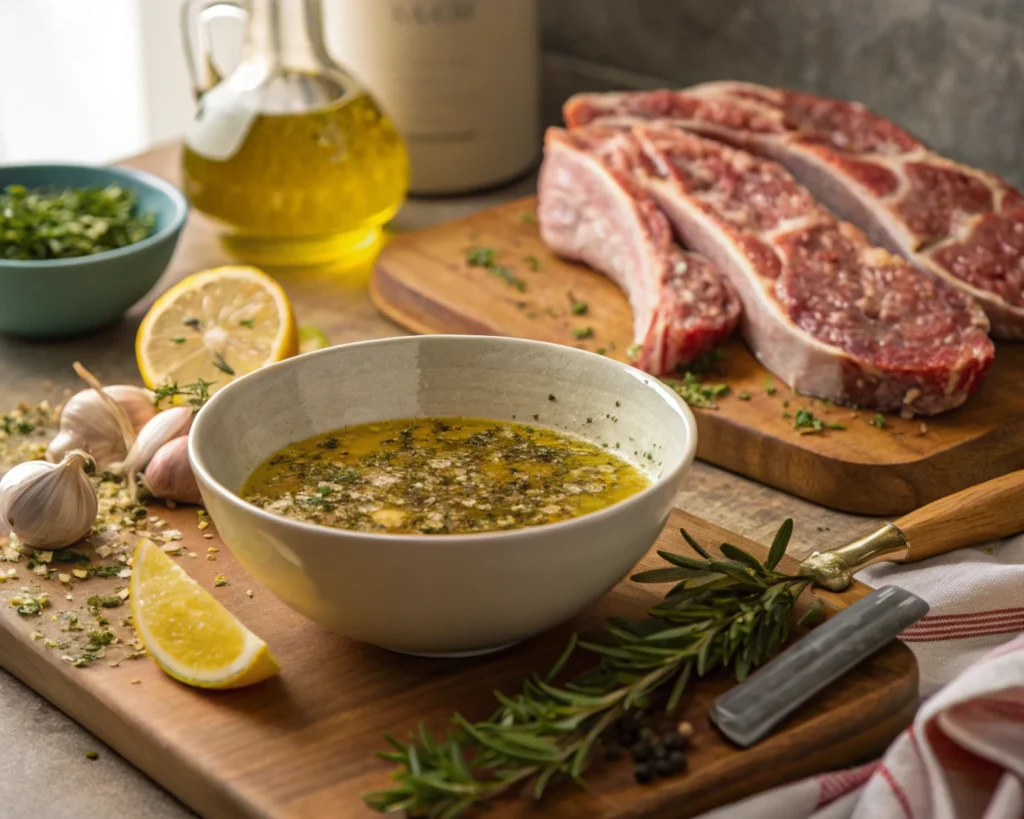
Best Side Dishes to Pair with Grilled Lamb Shoulder Chops
Grilled lamb shoulder chops shine brightest when paired with sides that complement their robust flavor profile. Vegetables roasted with herbs often mirror the aromatics used in lamb preparation, creating a cohesive flavor experience. Consider fingerling potatoes tossed with olive oil, garlic, and rosemary, then roasted until crisp-tender. Alternatively, a medley of Mediterranean vegetables like zucchini, bell peppers, and red onions takes on a sweet caramelization when grilled alongside the lamb, absorbing some of the meat’s rendered juices for additional flavor enhancement.
Grain-based sides offer textural contrast and absorbing capacity for the lamb’s flavorful juices. A pilaf of wild rice studded with toasted almonds and dried cranberries provides nutty complexity and slight sweetness. For a Mediterranean approach, couscous or bulgur wheat tossed with lemon zest, parsley, mint, and a touch of olive oil creates a light yet satisfying accompaniment. These grains can be prepared ahead and served at room temperature, making them practical for entertaining.
Fresh, vibrant salads provide welcome contrast to the richness of grilled lamb. Consider a Greek-inspired salad of cucumber, tomato, red onion, kalamata olives, and feta cheese, dressed simply with lemon juice and olive oil. For seasonal variation, a summer salad of watermelon, feta, and mint offers unexpected but delightful contrast, while autumn might call for roasted beet and arugula with crumbled goat cheese and balsamic reduction. These bright, acidic components help cut through the lamb’s richness and cleanse the palate between bites.
How to Enhance Flavor with Sauces and Dips
While perfectly grilled lamb shoulder chops need no embellishment, thoughtfully paired sauces can elevate the dining experience. Traditional Mediterranean accompaniments like tzatziki provide cooling contrast through the combination of yogurt, cucumber, and mint. Its creamy consistency and subtle acidity complement the lamb’s richness without overpowering its flavor.
For a more robust option, consider chimichurri—a vibrant Argentinian sauce combining parsley, oregano, garlic, olive oil, and vinegar. Its bright herbaceous notes and moderate acidity cut through the lamb’s richness, while its oil base helps it cling to the meat. Prepare chimichurri at least an hour before serving to allow flavors to meld, but serve at room temperature rather than chilled to avoid dulling the flavors.
Middle Eastern-inspired sauces like tahini-lemon offer creamy richness with nutty depth. Combine equal parts tahini and lemon juice, then thin with water to desired consistency. Add minced garlic, salt, and chopped parsley for a sauce that complements lamb’s natural flavor while adding its own distinctive character.
For wine-lovers, a reduction sauce incorporating the same wine served with the meal creates elegant harmony. Reduce a cup of full-bodied red wine with a sprig of rosemary, a crushed garlic clove, and a tablespoon of honey until syrupy, then mount with a tablespoon of cold butter for glossy richness. Strain before serving to remove solids and ensure silky texture.
Presentation Tips for a Restaurant-Quality Meal at Home
Elevating your grilled lamb shoulder chops from excellent to exceptional requires thoughtful presentation. Begin with proper plating temperature—warm plates prevent premature cooling, allowing diners to enjoy the full flavor spectrum. Place plates in a 200°F oven for 5 minutes before serving, or warm them with hot water and dry thoroughly.
For visual impact, consider the rule of odd numbers—serving three small chops creates more visual interest than two larger ones. Arrange them with a slight overlap rather than in perfect alignment, creating natural-looking composition. When slicing thicker chops for serving, cut against the grain at a slight angle, then fan the slices to showcase the perfect doneness.
Thoughtful garnishing adds both visual appeal and complementary flavors. A light scattering of flaky sea salt just before serving brings out the lamb’s natural flavors, while a drizzle of high-quality extra virgin olive oil adds appetizing sheen. Fresh herb sprigs—particularly rosemary or thyme—provide aromatic impact and visual contrast. For special occasions, consider edible flowers like nasturtium or pansies for unexpected but elegant touches.
Consider height and negative space when arranging components. Rather than spreading everything flat across the plate, stack elements strategically—perhaps resting the chops against a mound of grain or roasted vegetables. Leave some plate visible rather than crowding all components together, allowing each element to stand out.
Serving vessels matter significantly—rustic earthenware or slate for casual gatherings, white porcelain for modern presentation, or vintage china for elegant occasions. The subtle context these choices provide enhances the overall dining experience, transforming a simple meal into a memorable event.
Storage and Reheating Tips for Leftover Grilled Lamb
How to Store Grilled Lamb Shoulder Chops Properly
Proper storage begins immediately after your meal concludes. Rather than allowing leftover lamb shoulder chops to remain at room temperature for extended periods, refrigerate them within two hours of cooking (one hour in warm weather) to prevent bacterial growth. Before storage, allow the chops to cool slightly—10 to 15 minutes maximum—but never leave them to cool completely at room temperature.
For optimal preservation of flavor and texture, wrap each chop individually in aluminum foil before placing in an airtight container. This double-protection approach minimizes exposure to air, which can accelerate oxidation and flavor deterioration. If you expect to keep the lamb for more than a day, consider removing the bones first, as the meat surrounding bones tends to spoil more quickly.
Refrigerated lamb shoulder chops maintain peak quality for 3-4 days when properly stored. If you won’t consume them within this timeframe, freezing is a better option. For freezer storage, wrap each room-temperature chop tightly in plastic wrap, then in aluminum foil, before placing in a freezer-safe zip-top bag with the air expressed. Label with the date and contents. Properly frozen lamb shoulder chops maintain quality for up to three months, though they remain safe indefinitely at consistent freezer temperatures.
When planning to use frozen lamb, transfer it to the refrigerator for gradual thawing 24 hours before needed. This slow thawing method preserves moisture and texture far better than quick-thawing methods like microwaving or warm water immersion.
The Best Methods for Reheating While Keeping Them Juicy
Reheating lamb shoulder chops presents a significant challenge: maintaining moisture while bringing the meat to a safe and appetizing temperature. The sous vide method, if available, offers unparalleled results. Place the chops in a zip-top bag, express all air, and immerse in a water bath at 130°F for 20-30 minutes. This gentle, precise reheating ensures the meat never exceeds its original doneness temperature while allowing sufficient time for thorough warming.
For those without sous vide equipment, the oven provides the next best option. Preheat to 275°F—this low temperature minimizes additional cooking while allowing even warming. Place the chops on a wire rack over a baking sheet, add a tablespoon of water or broth to the sheet to create humidity, and cover the entire setup with aluminum foil. Heat for 15-20 minutes until the internal temperature reaches about 110-120°F (assuming they were originally cooked to medium-rare). For additional browning, you can finish with a quick sear in a hot skillet with a touch of oil.
The stovetop method works well for thinner chops. Use a heavy skillet over medium-low heat with a tablespoon of water or broth and a teaspoon of butter. Cover and heat for 2-3 minutes per side until warmed through, using the liquid and fat to maintain moisture through gentle steam and basting.
Regardless of reheating method, remember that leftover lamb will always be at its best when not heated past its original doneness temperature. A meat thermometer remains invaluable for preventing overcooking during reheating.
Creative Ways to Use Leftovers
Transforming leftover grilled lamb shoulder chops into new dishes often yields results so delicious you might intentionally grill extra. Mediterranean-inspired wraps offer a quick, satisfying option: dice the lamb into small pieces, warm briefly, then wrap in flat bread with tzatziki, diced cucumber, tomato, red onion, and fresh herbs. The cooling yogurt sauce and fresh vegetables complement the reheated lamb without requiring it to be perfectly moist.
Grain bowls provide endless versatility for repurposing lamb. Create a base of cooked quinoa, farro, or bulgur wheat, then add thinly sliced room-temperature lamb (no reheating required), roasted vegetables, a spoonful of hummus, crumbled feta, and a drizzle of tahini sauce. The room-temperature approach sidesteps reheating challenges entirely while creating a nutritionally complete meal.
Hearty salads showcase lamb’s flavor while requiring minimal reheating. Toss robust greens like arugula or kale with a light vinaigrette, then add quickly warmed and sliced lamb, toasted nuts, dried fruit, and bold cheese like blue or aged goat cheese. The contrasting temperatures—warm lamb against cool greens—creates textural and sensory interest.
For cooler weather, transform leftover lamb into rich soup by simmering the bones with aromatics to create stock, then add diced lamb toward the end of cooking with hearty vegetables and grains like barley or farro. This approach utilizes every part of the leftover chops, extracting maximum flavor while creating an entirely new dish.
Breakfast applications might surprise you—consider dicing chilled lamb finely and warming briefly in a skillet with leftover roasted potatoes and onions for a distinctive hash. Top with poached eggs and a dollop of harissa for a breakfast that elevates leftover lamb to luxury status.
Conclusion
Mastering grilled lamb shoulder chops is truly an exercise in culinary wisdom—understanding that sometimes the less expensive cuts offer the most rewarding flavor experiences when handled with care and knowledge. Throughout this guide, we’ve explored how the right combination of selection, preparation, cooking technique, and presentation transforms these humble chops into a dish worthy of celebration.
Remember that the secret to consistently perfect grilled lamb shoulder chops lies in respecting the meat’s natural qualities. Choose well-marbled chops of appropriate thickness, enhance their flavor with thoughtful marinades or rubs, master the two-zone grilling approach for that perfect balance of char and juiciness, and allow proper resting time before serving. These fundamental principles, rather than complicated techniques, are what separate good results from truly exceptional ones.
Don’t hesitate to make this recipe your own by experimenting with different herb combinations, serving with seasonal sides that reflect your local produce, or adapting the cooking method to your specific grill. The techniques we’ve shared provide a solid foundation, but your personal touches will make these grilled lamb shoulder chops a signature dish that friends and family request by name.
We’d love to hear how your grilled lamb shoulder chops turn out! Share your experience in the comments below—what marinade variations did you try? What side dishes complemented your meal? Did you discover any personal techniques that enhanced the results? Your insights might help fellow home cooks discover their own perfect approach to this versatile cut.
Subscribe to our newsletter for more recipes that celebrate underrated cuts and techniques that deliver maximum flavor with minimum fuss. And remember, sometimes the most impressive dishes aren’t about exotic ingredients or complex methods—they’re about understanding food fundamentals and bringing out the best in quality ingredients.
Are you ready to try this recipe?
There are no reviews yet. Be the first one to write one.

